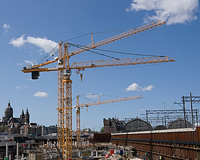Speaking to Rob Noel following the recent full-year results for Land Securities, the UK’s largest property company, provided a reminder of the calculated gamble that development plays in the property cycle.
Asked what we could expect to see in next year’s results, after his first full year in charge, the former Great Portland Estates property director paused before replying: “I hope you will see that the development programme was the right call.”
Could that have been an uncharacteristic glimmer of uncertainty from the City’s real estate golden boy, who has staked his reputation on rents in the Square Mile going up?
No, it was delivered with the confidence for which Noel is well known and which has guided him since his early days as an investment agent at the former property services minnow Nelson Bakewell.
The decision to restart the mothballed London development pipeline came midway through 2010 – six months after Noel joined Land Securities to lead its London portfolio business while overall control of the business was still in the hands of Francis Salway.
And the punt, to put it crudely, has paid off so far. In line with what one analyst called the “Noel Plan”, the listed giant’s results were buoyed by an 8% rise in the value of its 1.2m sq ft London development programme, while retail developments rose in value by 9.5% in the year to 31 March 2012.
Looking across the recent plethora of results released by the listed sector that have a March financial year-end, it is clear LandSec is not alone in developing its way out of the recession.
British Land also has its decision to hit the development button in 2010 to credit for its outperformance in the 12 months to the end of March this year.
The value of the REIT’s 4m sq ft office, retail and residential development programme rose 13.6% to £701m after it secured prelets on 50% of the office space under construction. This, in turn, delivered most of the group’s 2.6% uplift in the value of its portfolio to £10.3bn in the year.
GPE also announced full-year results that were ahead of forecasts, with a 12% hike in net asset value to 403p a share driven by a stronger-than-expected revaluation surplus of 9.2% and total returns of 12.5%.
Swapping income for NAV growth
The firm is making a so-far successful play to sacrifice income for NAV growth in the cushioned West End market, where there is a shortage of supply and solid occupational demand.
Chief executive Toby Courtauld likened the firm’s current position to 2005 when the total-return player sought to add value through “actions” such as development and asset management rather than riding the cycle like a passive, income-oriented company. In the last year alone, its developments increased in value by 13.7%, including a 2.4% hike in its final quarter, when values elsewhere had well and truly started heading south.
Hammerson also sees the value in City development – at least for the medium term.
The REIT is currently looking to offload its unwanted £550m mature office portfolio while fighting to hang on to its option to develop the City Corporation’s 500,000 sq ft London Wall Place scheme.
When it announced it was offloading its offices in December, it made clear that it planned to hang on to its three City office developments – Principal Place, London Wall Place and 50% of Bishopsgate Goodsyard – until it could secure prelets and turn its outlay into profits. With a bit more capital and the right occupiers in place, boss David Atkins hopes the firm can trigger further value before selling them.
The development drive is not limited to the UK’s biggest players. Helical Bar’s long-time leader, Mike Slade, who in 2009 said he was licking his lips at the prospect of development in the City, is now in a position to make gains.
Reading his statement accompanying the group’s recent full-year results, you could almost see the real estate sage salivating over the returns expected from his London development projects, which include plans for a 450,000 sq ft mixed-use development at Barts Square, EC1, and a 1.25m sq ft residential-led scheme at White City, W12.
It has been a long, dark haul for the former darling of the stock market, but finally Helical looks set to return to form – a sentiment shared by all the UK major property developers now focusing on what they do best.











